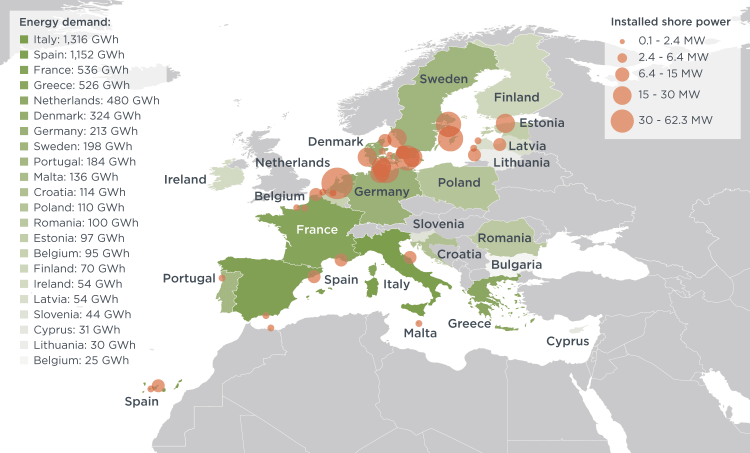A new study by The International Council on Clean Transportation (ICCT) estimates that the EU needs to triple or quadruple its installed shore power by 2030 to meet regulatory targets.
According to ICCT, currently, 51 ports in 15 EU coastal Member States have shore power infrastructure, supplying 309 MW of power, 283 MW of which are intended for container, passenger, and cruise ships.
Αccording to the FuelEU Maritime regulation, Article 6, starting January 1, 2030, container and passenger ships greater than or equal to 5,000 gross tonnage (GT) will connect to shore power and replace their electricity needs in the major EU ports listed in the trans-European transport network (TEN-T).
ICCT estimates the EU needs to triple or quadruple its installed shore power by 2030 to meet the current ambitions of the FuelEU Maritime regulation and AFIR, depending on whether Member States supply enough shore power to satisfy the average or maximum demand of container, passenger, and cruise ships.
 ICCT also notes that the current level of ambitions of the FuelEU Maritime regulation and AFIR will only lead to a 24% reduction in the EU’s estimated annual 4.37 Mt at-berth CO2 emissions.
ICCT also notes that the current level of ambitions of the FuelEU Maritime regulation and AFIR will only lead to a 24% reduction in the EU’s estimated annual 4.37 Mt at-berth CO2 emissions.
The FuelEU Maritime regulation, which focuses on zero-emission ships, only applies to passenger and container ships, as they have the highest emissions per ship while moored at the quayside.
The AFIR, Article 9, regulates shore power supply by incentivizing infrastructure development with a standardized shore-side electricity supply chain in TEN-T network ports.
However, the AFIR and the FuelEU Maritime regulation are only partially harmonized, with the AFIR having more additional requirements and exemptions related to port calls volume, limiting shore power supply to 90% of demand, and exempting ports with fewer averaged port calls and those located on remote islands. These differences could lead to obstacles in implementation.
As a result, ICCT presents the following policy recommendations:
- To achieve a 100% at-berth reduction in CO2 emissions, the forthcoming revision of both regulations should include a requirement for all ships greater than or equal to 400 GT to connect to shore power in EU ports. We estimate that to eliminate all at-berth CO2 emissions from ships would require nearly 2,000 MW of additional shore power installation to meet average at-berth annual energy demands, and about 3,300 MW for peak energy demand.
- Boilers should be also retrofitted, electrified, or connected to shore power facilities, just like auxiliary engines, since they are responsible for 44% of all at-berth CO2 emissions.
- Technical and logistical challenges should be addressed in the regulations, such as an unclear delegation of responsibilities between ship operators and port authorities, voltage and frequency incompatibility, berth space availability, charging time spans, and power quality.
- Clear goals should be established for the share of renewables in the electricity grid used for shore power supply.






























































